
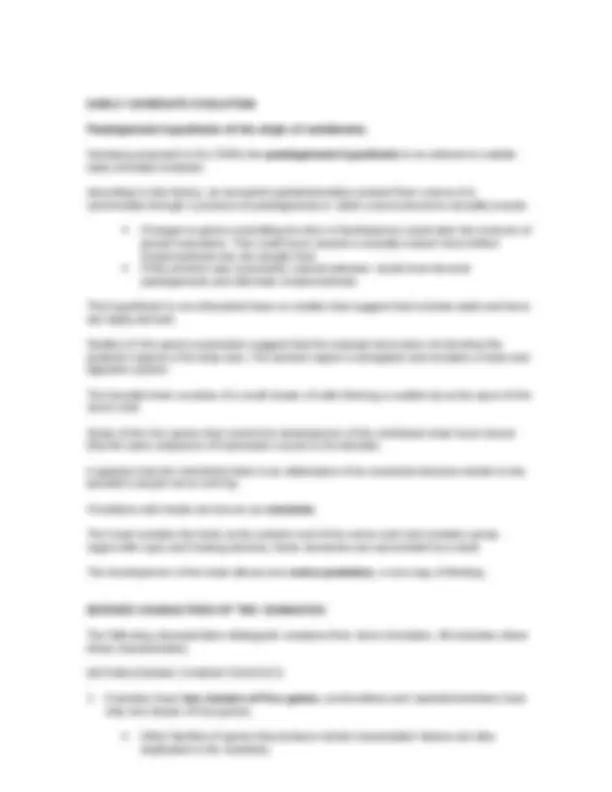
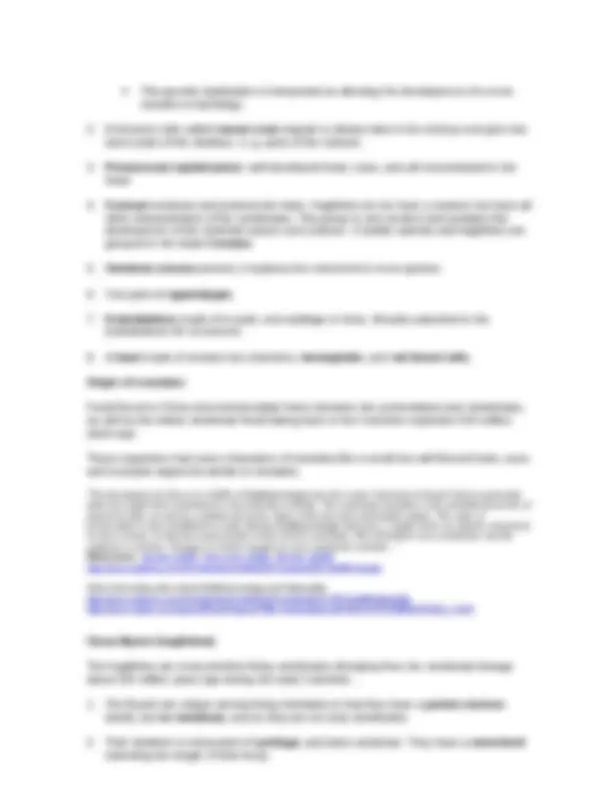
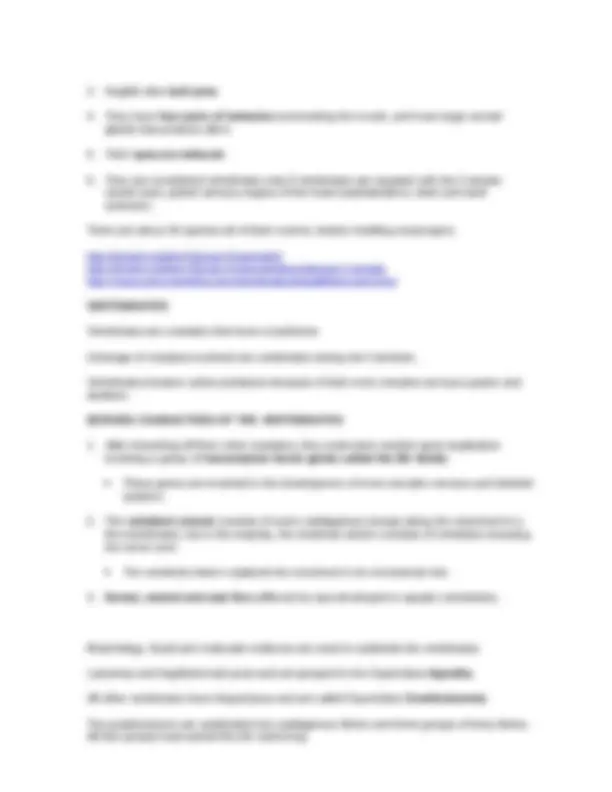
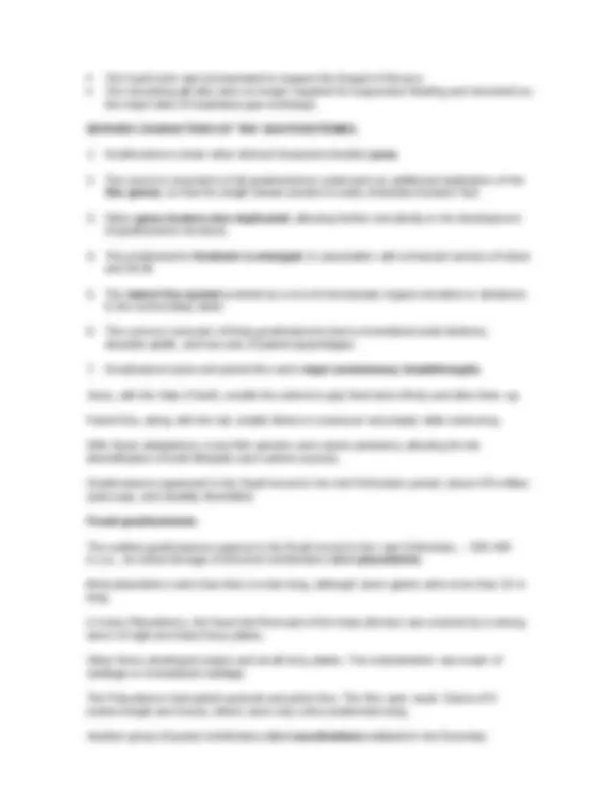
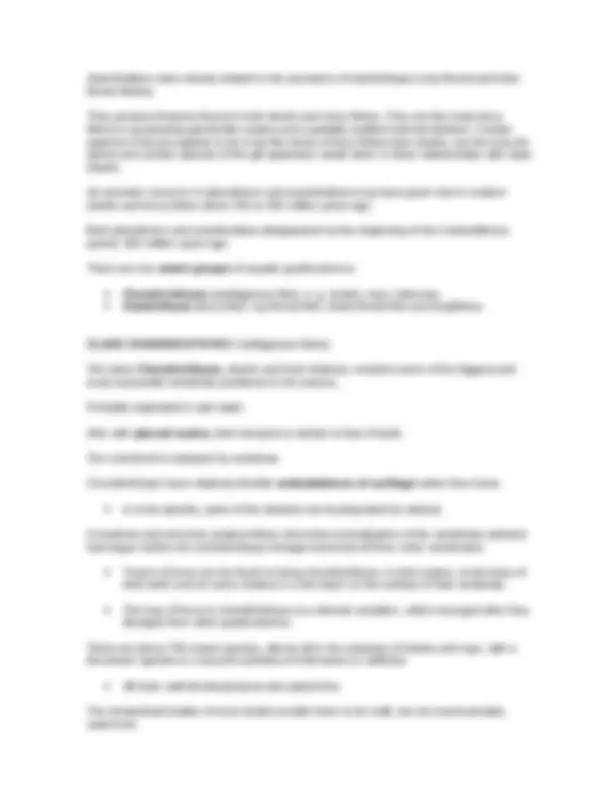

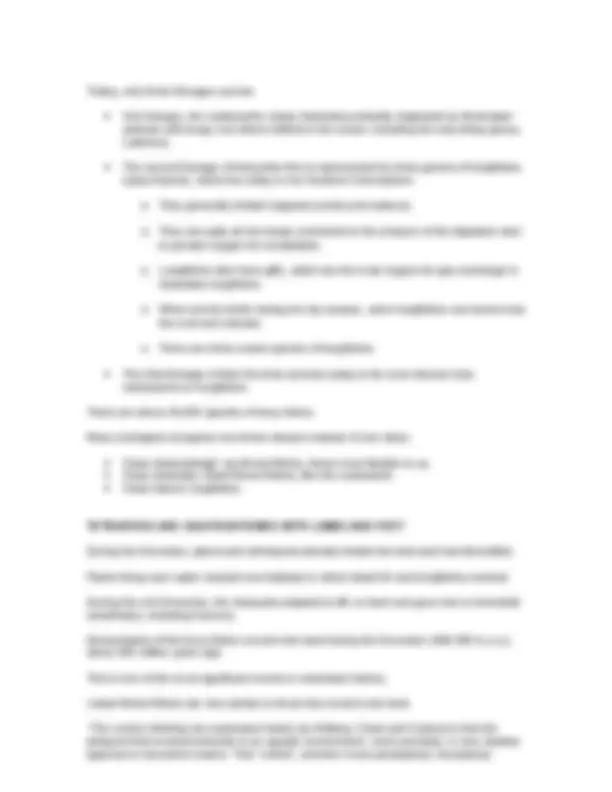
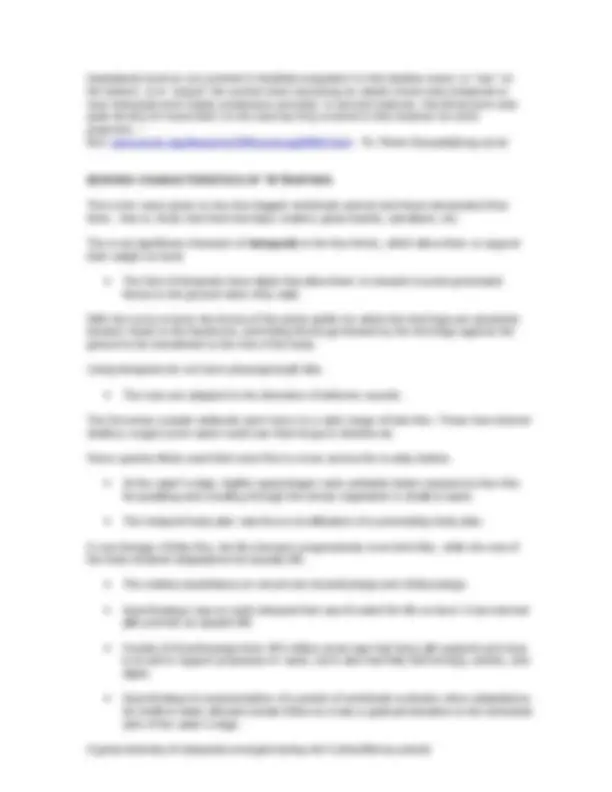
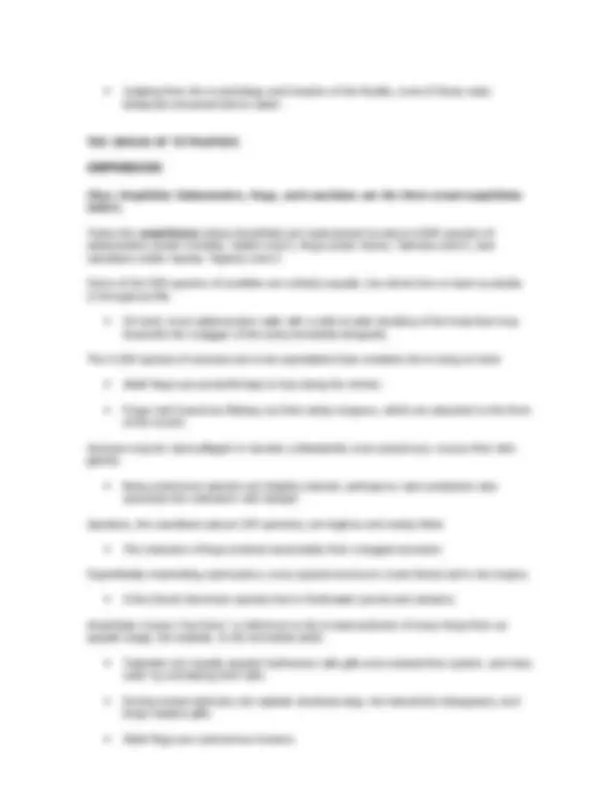
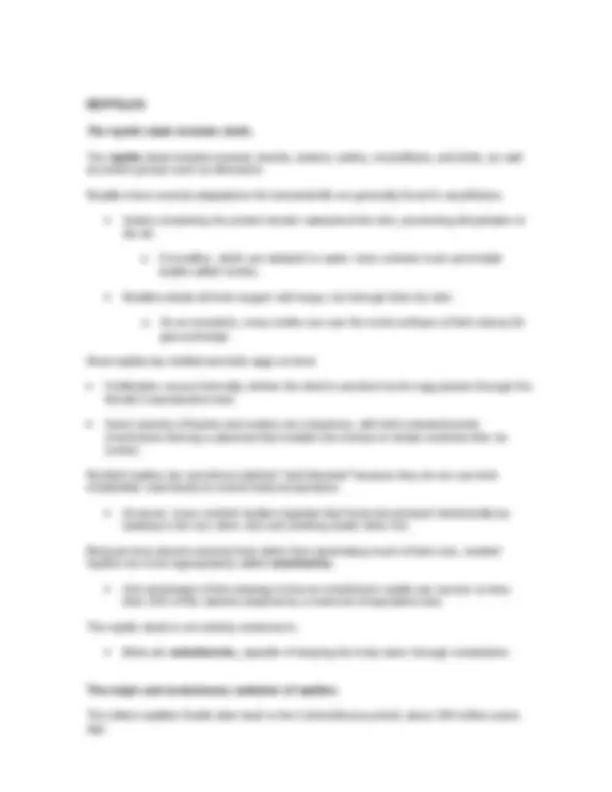
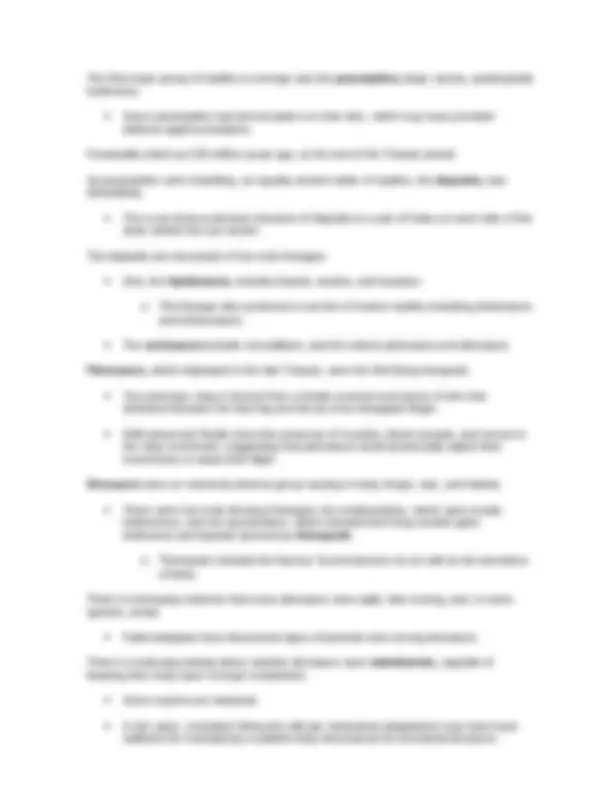
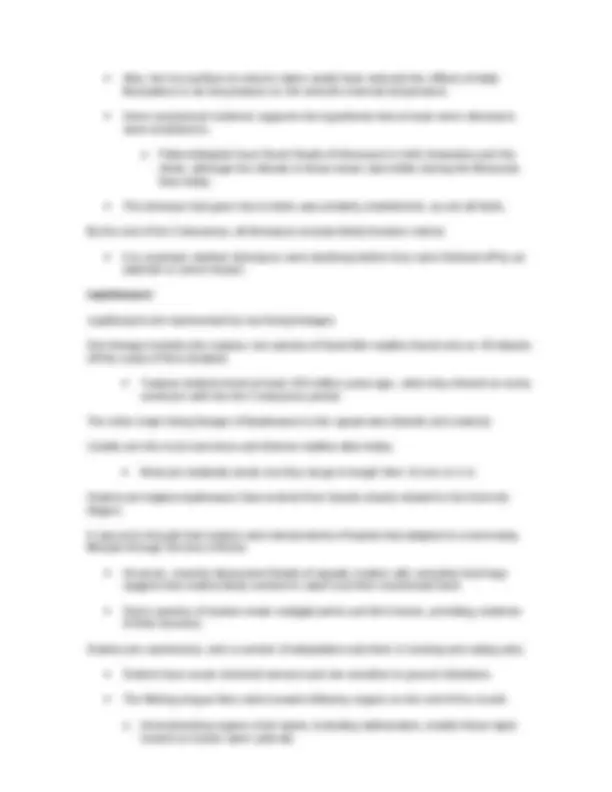
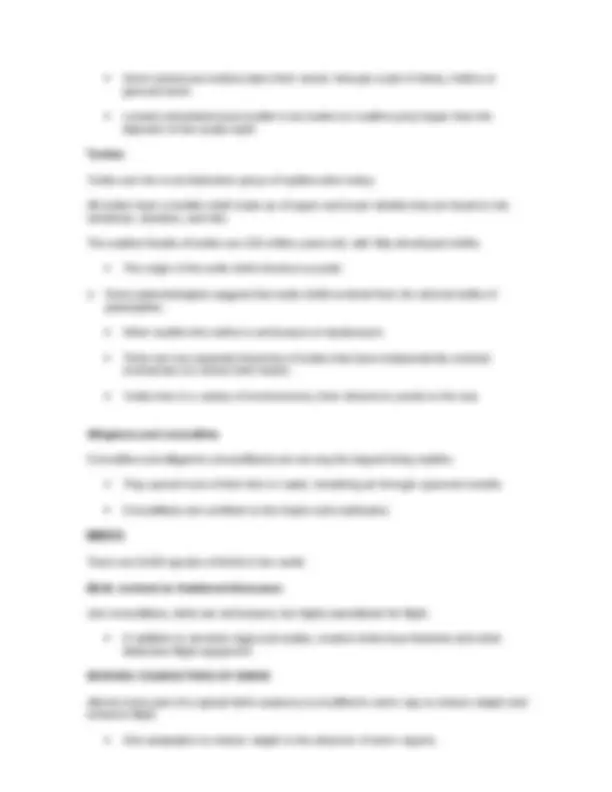
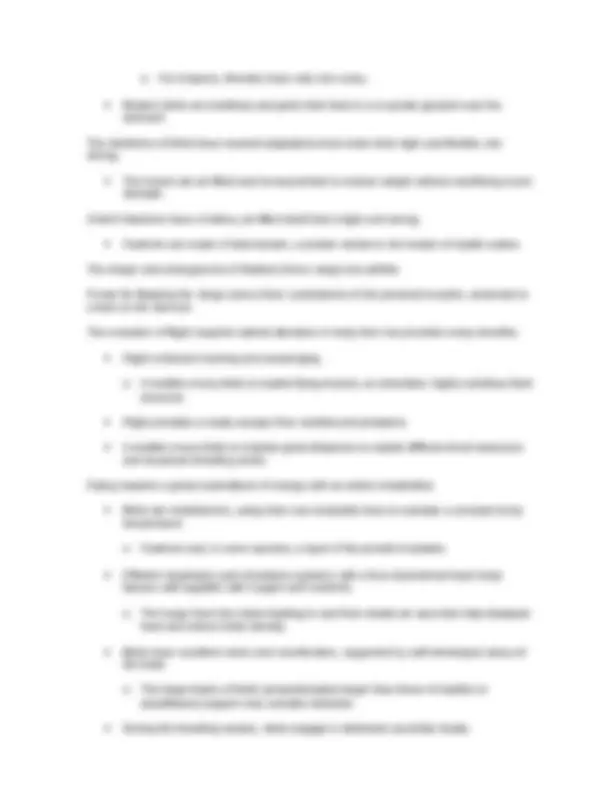
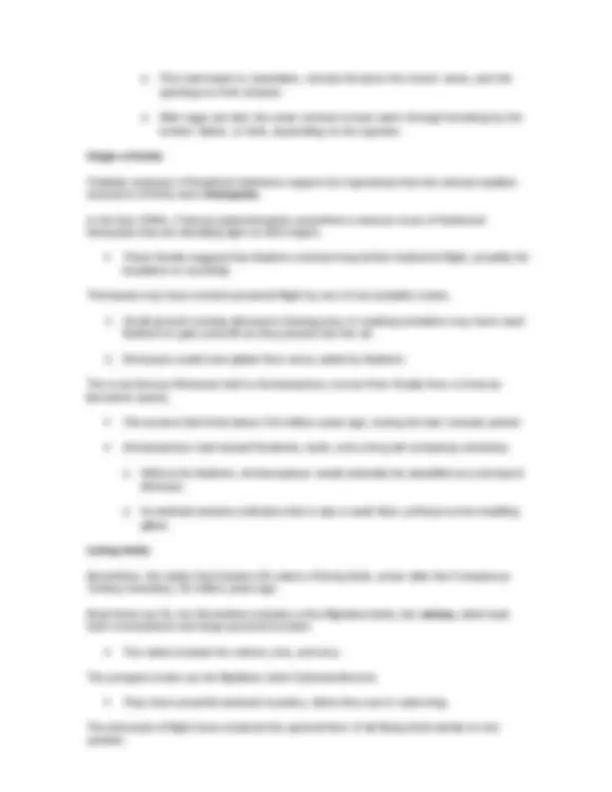
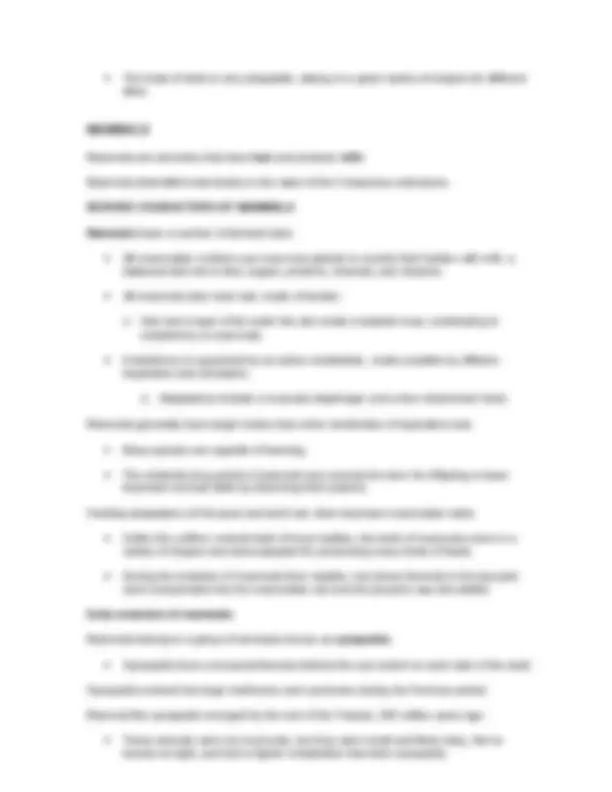
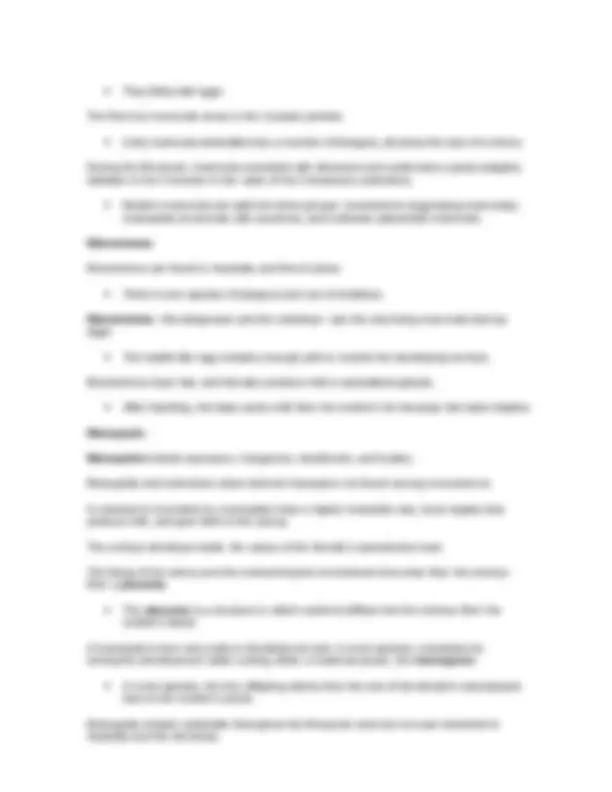

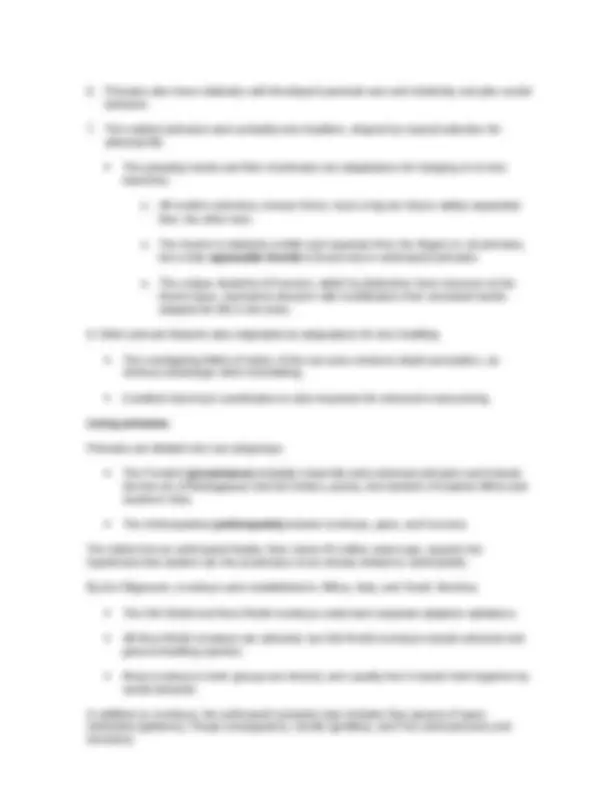
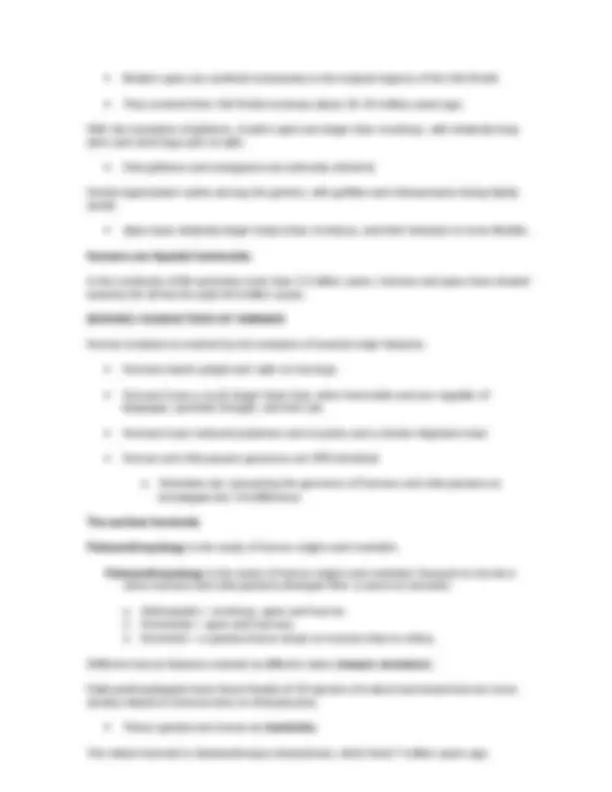
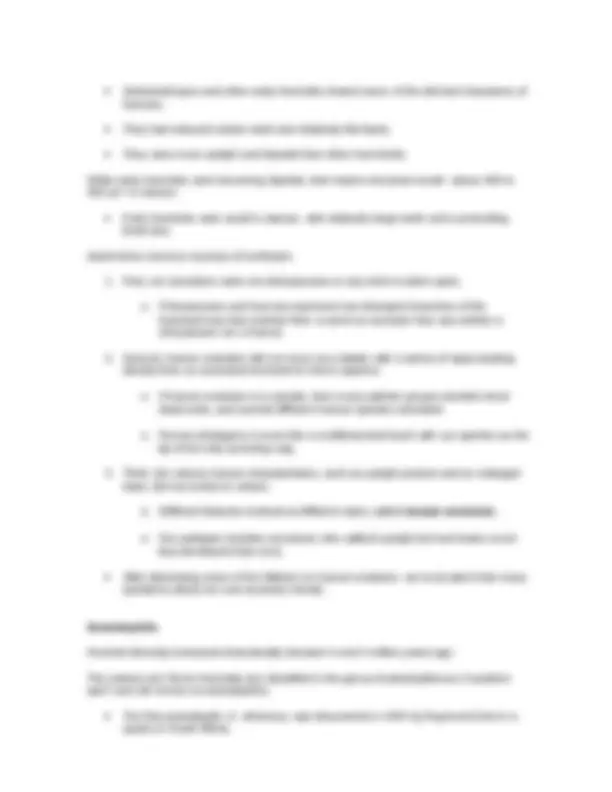
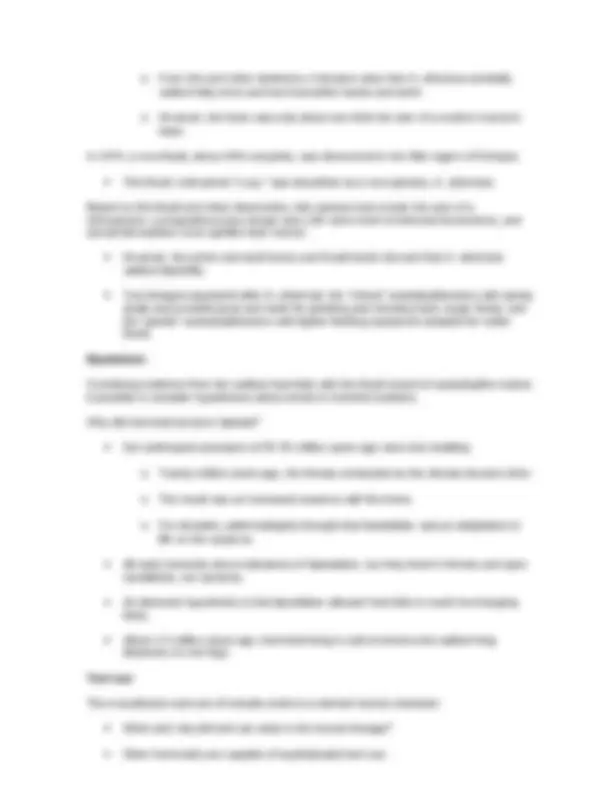
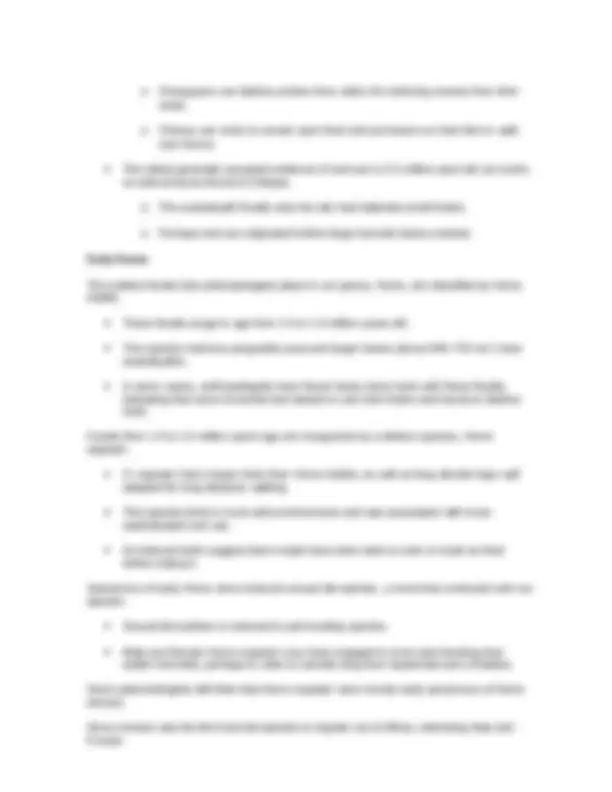
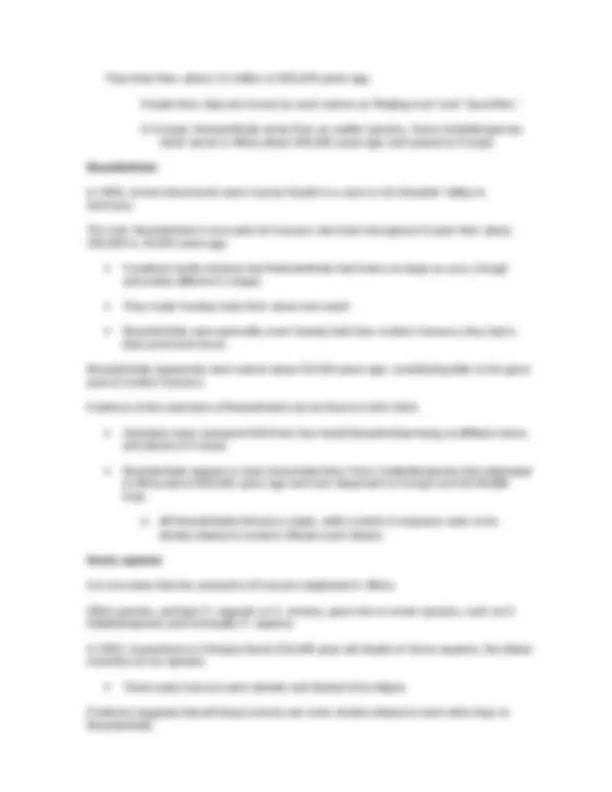



Study with the several resources on Docsity

Earn points by helping other students or get them with a premium plan


Prepare for your exams
Study with the several resources on Docsity

Earn points to download
Earn points by helping other students or get them with a premium plan
Community
Ask the community for help and clear up your study doubts
Discover the best universities in your country according to Docsity users
Free resources
Download our free guides on studying techniques, anxiety management strategies, and thesis advice from Docsity tutors
Material Type: Notes; Professor: Salgado; Class: Principles of Biology II; Subject: Biology; University: Christian Brothers University; Term: Unknown 1989;
Typology: Study notes
1 / 33

This page cannot be seen from the preview
Don't miss anything!


























By the beginning of the Cambrian, 540 million years ago, a great variety of animals inhabited the earth’s oceans. Claws, mandible, protective plates and spikes, complex mouth parts, teeth, skeletons, limbs. Hard parts and skeletons appeared that initiated changes in the location and attachment of tissues. These hard parts provided protection, support and teeth (for predators). Vertebrates remain restricted to the oceans for nearly 200 million years until Devonian ( m.y.a.). By the Devonian, 360 m.y.a., the transition to land took place. Deuterostomes have two main branches, Echinodermata and Chordata. The phylum Chordata is divided into three subphyla:
This genetic duplication is interpreted as allowing the development of a more complex morphology.
Their eyes were very large. All are extinct but considered more advanced than hagfishes, which still survive to this day. Ostracoderms thrived between 450 and 375 million years ago, from the Ordovician to the late Devonian. They had bony external shields that covered the head and most of the trunk. They were small, less than 50 cm (20 inches) long. Their internal skeleton was made of cartilage. They lacked paired fins but some has side flaps that helped in steering. They were probably bottom dwellers that sucked up mud or suspension feeders that trapped their food in the gills. They declined rapidly in the Devonian after true fishes evolved and became extinct by the end of the Devonian. Recent research considers some member of this group to be more closely related to jawed fish than to other ostracoderms. Origins of bones and teeth. The vertebrate skeleton evolved initially as a structure of unmineralized cartilage. Mineralization of the skeleton took place after the lampreys diverged from other vertebrates. What initiated the process of mineralization in vertebrates? Mineralization may have been associated with the transition to new feeding mechanisms. The earliest known mineralized structures in vertebrates were conodont dental elements. Mineralization began in the mouth according to Donoghue. The armor seen in later jawless vertebrates was derived from dental mineralization. Only in more derived vertebrates did the endoskeleton begin to mineralize, starting with the skull. GNATHOSTOMES During the Silurian (439-409 mya) and the early Devonian (409-390 mya) the agnathans were replaced by the gnathostomes , the jawed fishes. Evolutionary developments : Jaws allowed a more efficient carnivorous behavior by grabbing, tearing and chewing. Flat-opposed teeth can grind hard food. Paired fins became more developed. Jaws allowed these fishes to exploit food sources that were unavailable to agnathans. Development of the jaw, a hypothesis. Anterior pharyngeal gill arches previously used for filter feeding became the mandible and palatoquadrate bone.
The hyoid arch was incorporated to support the hinged of the jaw. The remaining gill slits were no longer required for suspension feeding and remained as the major sites of respiratory gas exchange. DERIVED CHARACTERS OF THE GNATHOSTOMES****.
Powerful axial muscles power undulations of the body and caudal fin to drive the fish forward. The dorsal fins provide stabilization. While some buoyancy is provided by low-density oils in the large liver, the flow of water over the pectoral and pelvic fins also provides lift to keep the animal suspended in the water column. Continual swimming also ensures that water flows into the mouth and out through the gills. Some sharks and many skates and rays spend much time resting on the seafloor, using the muscles of their jaws and pharynx to pump water over the gills. Most sharks are carnivores that swallow their prey whole or use their powerful jaws and sharp teeth to tear flesh from animals too large to swallow. In contrast, the largest sharks and rays are suspension feeders that consume plankton. Sharks have several rows of teeth that gradually move to the front of the mouth as old teeth are lost. Within the intestine of a shark is a spiral valve, a corkscrew-shaped ridge that increases surface area and prolongs the passage of food along the short digestive tract. Acute senses are adaptations that go along with the active, carnivorous lifestyle of sharks. Sharks have sharp vision but cannot distinguish colors. Their acute olfactory sense (smelling) occurs in a pair of nostrils that do not function in breathing. Sharks can detect electrical fields, including those generated by the muscle contractions of nearby prey, through patches of specialized skin pores. The lateral line system, a row of microscopic organs sensitive to pressure changes, can detect low-frequency vibrations. In sharks, the whole body transmits sound to the hearing organs of the inner ear. Shark eggs are fertilized internally. Males transfer sperm via claspers on their pelvic fins to the reproductive tract of the female. Oviparous sharks encase their eggs in protective cases and lay them outside the mother’s body. These hatch months later as juveniles. Ovoviviparous sharks retain fertilized eggs in the oviduct. The embryo completes development in the uterus, nourished by the egg yolk.
A few sharks are viviparous, providing nutrients through a placenta to the developing offspring. The reproductive track of the shark opens along with the excretory and digestive systems into a chamber called the cloaca , which in turn opens to the outside. Rays are closely related to sharks, but they have adopted a very different lifestyle. Most rays are flattened bottom dwellers that crush mollusks and crustaceans in their jaws. The enlarged pectoral fins of rays are used like wings to propel the animal through the water. The tail of many rays is whiplike and may bear venomous barbs for defense against threats. Chondrichthyans have changed little in more than 300 million years. They are severely threatened by overfishing. In 2003, researchers reported that shark stocks in the northwest Atlantic declined 75% in 15 years. CLASS OSTEICHTHYES Bony fishes Probably originated in fresh water. The vast majority of bony fishes belong to a clade of gnathostomes called the Osteichthyes (meaning “bony fish”). Systematists today include tetrapods with bony fish in Osteichthyes, which otherwise would be paraphyletic. Skin usually with overlapping dermal scales , some fish without scales. The skin of bony fishes is often covered with thin, flattened bony scales that differ in structure from the tooth-like scales of sharks. Glands in the skin secrete mucus that reduces drag in swimming. Skeleton with many vertebrae replace the notochord. Nearly all bony fishes have an ossified endoskeleton with a hard matrix of calcium phosphate. It is not clear when the shift to a bony skeleton took place during gnathostome evolution. Bony fishes breathe by drawing water over four or five pairs of gills located in chambers covered by a protective flap, the operculum.
Today, only three lineages survive. One lineage, the coelacanths (class Actinistia) probably originated as freshwater animals with lungs, but others shifted to the ocean, including the only living genus, Latimeria. The second lineage of living lobe-fins is represented by three genera of lungfishes (class Dipnoi), which live today in the Southern Hemisphere. o They generally inhabit stagnant ponds and swamps. o They can gulp air into lungs connected to the pharynx of the digestive tract to provide oxygen for metabolism. o Lungfishes also have gills, which are the main organs for gas exchange in Australian lungfishes. o When ponds shrink during the dry season, some lungfishes can burrow into the mud and estivate. o There are three extant species of lungfishes. The third lineage of lobe-fins that survives today is far more diverse than coelacanths or lungfishes. There are about 30,000 species of bony fishes. Many zoologists recognize now three classes instead of one class: Class Actinopterigii: ray-finned fishes, those most familiar to us. Class Actinistia: lobed-finned fishes, like the coelacanth. Class Dipnoi: lungfishes. TETRAPODS ARE GNATHOSTOMES WITH LIMBS AND FEET During the Devonian, plants and arthropods already inhabit the land and had diversified. Plants living near water created new habitats in which lobed-fin and lungfishes evolved. During the mid-Devonian, the tetrapods adapted to life on land and gave rise to terrestrial vertebrates, including humans. Descendants of the bony fishes moved onto land during the Devonian (408-380 m.y.a.), about 360 million years ago. This is one of the most significant events in vertebrate history. Lobed-finned fishes are very similar to those that moved onto land. "The current thinking (as expressed mainly by Ahlberg, Clack and Coates) is that the tetrapod limb evolved primarily in an aquatic environment, more precisely, in very shallow lagoonal or lacustrine waters. That "urlimb", whether it was pentadactyl, hexadactyl,
heptadactyl (and so on) evolved to facilitate propulsion in that shallow water, to "row" on the bottom, or to "propel" the animal when launching an attack (most early tetrapods or near tetrapods were highly predacious animals). In second instance, this limbs were also quite decent for locomotion on the land but they evolved in first instance for other purposes..." Ref: www.cmnh.org/dinoarch/1998Jun/msg00804.html - 7k; Pieter.Depuydt@rug.ac.be DERIVED CHARACTERISTICS OF TETRAPODS This is the name given to any four legged vertebrate animal and those descended from them, that is, those that have lost legs: snakes, glass lizards, caecilians, etc. The most significant character of tetrapods is the four limbs, which allow them to support their weight on land. The feet of tetrapods have digits that allow them to transmit muscle-generated forces to the ground when they walk. With the move to land, the bones of the pelvic girdle (to which the hind legs are attached) became fused to the backbone, permitting forces generated by the hind legs against the ground to be transferred to the rest of the body. Living tetrapods do not have pharyngeal gill slits. The ears are adapted to the detection of airborne sounds. The Devonian coastal wetlands were home to a wide range of lobe-fins. Those that entered shallow, oxygen-poor water could use their lungs to breathe air. Some species likely used their stout fins to move across the muddy bottom. At the water’s edge, leglike appendages were probably better equipment than fins for paddling and crawling through the dense vegetation in shallow water. The tetrapod body plan was thus a modification of a preexisting body plan. In one lineage of lobe-fins, the fins became progressively more limb-like, while the rest of the body retained adaptations for aquatic life. The earliest amphibians on record are Acanthostega and Ichthyostega. Acanthostega was an early tetrapod that was ill suited for life on land. It has internal gills and led an aquatic life. Fossils of Acanthostega from 365 million years ago had bony gill supports and rays in its tail to support propulsion in water, but it also had fully formed legs, ankles, and digits. Acanthostega is representative of a period of vertebrate evolution when adaptations for shallow water allowed certain fishes to make a gradual transition to the terrestrial side of the water’s edge. A great diversity of tetrapods emerged during the Carboniferous period.
Many amphibians do not live a dualistic—aquatic and terrestrial—life. There are some strictly aquatic and some strictly terrestrial: frogs, salamanders, and caecilians. The larvae of salamanders and caecilians look like adults and are also carnivorous. Paedomorphosis, the retention of some larval features in a sexually mature adult, is common among some groups of salamanders. For example, the mudpuppy ( Necturus ) retains gills and other larval features when sexually mature. Most amphibians retain close ties with water and are most abundant in damp habitats. Those adapted to drier habitats spend much of their time in burrows or under moist leaves where the humidity is higher. Most amphibians rely heavily on their moist skin to carry out gas exchange with the environment. o Some terrestrial species lack lungs entirely and breathe exclusively through their skin and oral cavity. Amphibian eggs lack a shell and dehydrate quickly in dry air. Most species have external fertilization, with eggs shed in ponds or swamps or at least in moist environments. Some species lay vast numbers of eggs in temporary pools where mortality is high. Others display various types of parental care and lay relatively few eggs. o In some species, males or females may house eggs on the back, in the mouth, or even in the stomach. o Some species are ovoviviparous or viviparous, retaining the developing eggs in the female reproductive tract until released as juveniles. Many amphibians display complex and diverse social behavior, especially during the breeding season. Then many male frogs fill the air with their mating calls as they defend breeding territories or attract females. In some terrestrial species, migrations to specific breeding sites may involve vocal communication, celestial navigation, or chemical signaling. For the past 25 years, zoologists have been documenting a rapid and alarming decline in amphibian populations throughout the world. Several causes that have been proposed include habitat degradation, the spread of a pathogen (a chytrid fungus), and acid precipitation.
Acid precipitation is damaging to amphibians because of their dependence on wet places for completion of their life cycles.
Amniotes have amniotic eggs The amniote clade consists of the mammals and reptiles (including birds). The evolution of amniotes from an amphibian ancestor involved many adaptations for terrestrial living. The amniotic egg is the major derived character of the clade. DERIVED CHARACTERS OF AMNIOTES Evolution of the amniotic egg expanded the success of vertebrates on land. Inside the shell of the amniotic egg are several extraembryonic membranes that function in gas exchange, waste storage, and the transfer of stored nutrients to the embryo. The amniotic egg is named for one of these membranes, the amnion, which encloses a fluid-filled “private pond” that bathes the embryo and acts as a hydraulic shock absorber. The amniotic eggs enabled terrestrial vertebrates to complete their life cycles entirely on land. In contrast to the shell-less eggs of amphibians, the amniotic eggs of most amniotes have a shell that retains water and can be laid in a dry place. The calcareous shells of bird eggs are inflexible, while the leathery eggs of many reptiles are flexible. Most mammals have dispensed with the shell. o The embryo implants in the wall of the uterus and obtains its nutrition from the mother. Amniotes acquired other adaptations to terrestrial life, including less-permeable skin and the increasing use of the rib cage to ventilate the lungs. Amniotes adopt a more elevated stance than earlier tetrapods and living amphibians. Early amniotes The most recent common ancestor of living amphibians and amniotes lived about 340 million years ago, in the early Carboniferous period. No fossils of amniotic eggs have been found from that time. Early amniotes lived in drier environments than did earlier tetrapods. Some were herbivores, with grinding teeth. Others were large and predatory.
The first major group of reptiles to emerge was the parareptiles, large, stocky, quadrupedal herbivores. Some parareptiles had dermal plates on their skin, which may have provided defense against predators. Parareptiles died out 200 million years ago, at the end of the Triassic period. As parareptiles were dwindling, an equally ancient clade of reptiles, the diapsids, was diversifying. The most obvious derived character of diapsids is a pair of holes on each side of the skull, behind the eye socket. The diapsids are composed of two main lineages. One, the lepidosaurs, includes lizards, snakes, and tuataras. o This lineage also produced a number of marine reptiles including plesiosaurs and ichthyosaurs. The archosaurs include crocodilians, and the extinct pterosaurs and dinosaurs. Pterosaurs, which originated in the late Triassic, were the first flying tetrapods. The pterosaur wing is formed from a bristle-covered membrane of skin that stretched between the hind leg and the tip of an elongated finger. Well-preserved fossils show the presence of muscles, blood vessels, and nerves in the wing membrane, suggesting that pterosaurs could dynamically adjust their membranes to assist their flight. Dinosaurs were an extremely diverse group varying in body shape, size, and habitat. There were two main dinosaur lineages: the ornithischians, which were mostly herbivorous, and the saurischians, which included both long-necked giant herbivores and bipedal carnivorous theropods. o Theropods included the famous Tyrannosaurus rex as well as the ancestors of birds. There is increasing evidence that many dinosaurs were agile; fast moving; and, in some species, social. Paleontologists have discovered signs of parental care among dinosaurs. There is continuing debate about whether dinosaurs were endothermic, capable of keeping their body warm through metabolism. Some experts are skeptical. In the warm, consistent Mesozoic climate, behavioral adaptations may have been sufficient for maintaining a suitable body temperature for terrestrial dinosaurs.
Also, the low surface-to-volume ratios would have reduced the effects of daily fluctuations in air temperature on the animal’s internal temperature. Some anatomical evidence supports the hypothesis that at least some dinosaurs were endotherms. o Paleontologists have found fossils of dinosaurs in both Antarctica and the Arctic, although the climate in those areas was milder during the Mesozoic than today. The dinosaur that gave rise to birds was certainly endothermic, as are all birds. By the end of the Cretaceous, all dinosaurs (except birds) became extinct. It is uncertain whether dinosaurs were declining before they were finished off by an asteroid or comet impact. Lepidosaurs Lepidosaurs are represented by two living lineages. One lineage includes the tuatara, two species of lizard-like reptiles found only on 30 islands off the coast of New Zealand. Tuatara relatives lived at least 220 million years ago, when they thrived on every continent well into the Cretaceous period. The other major living lineage of lepidosaurs is the squamates (lizards and snakes). Lizards are the most numerous and diverse reptiles alive today. Most are relatively small, but they range in length from 16 mm to 3 m. Snakes are legless lepidosaurs that evolved from lizards closely related to the Komodo dragon. It was once thought that snakes were descendents of lizards that adapted to a burrowing lifestyle through the loss of limbs. However, recently discovered fossils of aquatic snakes with complete hind legs suggest that snakes likely evolved in water and then recolonized land. Some species of snakes retain vestigial pelvic and limb bones, providing evidence of their ancestry. Snakes are carnivorous, and a number of adaptations aid them in hunting and eating prey. Snakes have acute chemical sensors and are sensitive to ground vibrations. The flicking tongue fans odors toward olfactory organs on the roof of the mouth. o Heat-detecting organs of pit vipers, including rattlesnakes, enable these night hunters to locate warm animals.